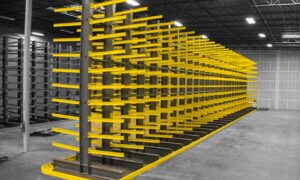Fabric shelters are a great way to protect your assets from the elements. Designed for temporary or semi-permanent use, fabric shelters can be used for a wide range of applications, including storage, workshops, tyre change bays and assembly areas. If you’re looking for an affordable solution that can provide years of service, then investing in a fully engineered fabric shelter might be the perfect solution.
The history of fabric shelters
Fabric shelters have been around for hundreds of years, used in many applications worldwide. In the 1960s, fabric structures began to be used for commercial and industrial purposes, and they were used as warehouses, manufacturing, and sports facilities. The development of new materials, such as vinyl-coated polyester and PVC fabrics, made it possible to create larger and more permanent fabric structures. In 2003, the concept of the container-mounted fabric shelter was born, and this concept revolutionized how many industries protect their people and assets today.
Allshelter fabric shelters are made from polyethylene (HDPE), a highly durable material that’s easy to clean and resistant to corrosive materials, salt, and abrasions from sand, straw, and dust. It makes them ideal for use around heavy machinery where hazardous substances may exist or even dust from dirt roads nearby. Fabric structures can be made to suit various needs and can be designed to withstand extreme weather conditions.
The many uses of fabric shelters
Fabric shelters can be used for various mining, construction, industrial, waste management, and aviation applications. The versatile nature of fabric shelters makes them a great shelter solution for tire change bays, painting and sandblasting booths, assembly areas, and storage areas. With the option of many different sizes and the flexibility to be customized with doors, end walls, lighting, and much more, fabric shelters are designed to suit your needs. Fabric shelters are often used as temporary structures because they’re quick and easy to assemble, but they can also be used for semi-permanent applications.
A smart investment that can be used for multiple purposes.
Fabric shelters are smart investments because they can be used for multiple purposes. As a temporary or semi-permanent solution, fabric shelters are ideal for many applications. With the ability to be relocated, they can be utilized at different locations for different purposes. Investing in Allshelter is a smart choice for companies looking for a cost-effective, durable, and customizable industrial shelter solution. Their shelters are made from high-quality materials, including PVC fabrics that are UV resistant, fire retardant, and designed to withstand harsh weather conditions.
Their shelters are designed to be easy to install and relocate and can be outfitted with various features such as ventilation, lighting, and insulation to meet specific needs. The durability and low maintenance requirements of Allshelter’s fabric shelters make them a cost-effective long-term investment for businesses looking to reduce their construction and maintenance costs.
Benefits of using a fabric shelter for industrial purposes
Fabric shelters are cost-effective and quick to assemble. Fabric dome shelters are designed to be relocatable and are ideal for projects potentially moving to another site. Designed and engineered to Australian Standards, Allshelter’s fabric shelters can be used in various environments–from the desert to the tropics, fabric shelters protect from extreme weather conditions. They can be used for many years without needing replacement parts or repairs; some fabrics are flame resistant! Let’s delve into some of these benefits:
Cost-effectiveness: Fabric shelters are generally more affordable than traditional brick-and-mortar buildings. They can be constructed quickly and require fewer materials, lowering construction costs.
Portability: Fabric structures are often designed to be portable, which means they can be easily relocated or expanded as needed. These fabric structures are particularly useful for industries that require temporary or mobile structures, such as construction sites, mining operations, or oil and gas exploration.
Quick construction: Fabric shelters can be erected much faster than traditional buildings, often taking only a fraction of the time, allowing companies to get their operations up and running more quickly, reducing downtime and lost productivity.
Customizability: Fabric structures can be designed to meet specific needs, such as size, shape, and function. They can also be outfitted with various features, including ventilation, insulation, lighting, and heating/cooling systems.
Durability: Modern fabric structures are made from high-quality materials that withstand harsh weather conditions and heavy use. They are also resistant to fire, mold, and other types of damage.
Energy efficiency: Fabric structures are often designed to be energy-efficient, which means they can help companies reduce their energy costs and carbon footprint. They can be insulated to prevent heat loss in the winter and to reduce heat gain in the summer, resulting in lower energy or power bills.
Final Thought
With its many benefits and versatility, fabric shelters are a smart investment for any industry. They can be used for temporary storage, manufacturing, or even permanent buildings. The main benefit is that the shelters are convenient to set up and take down when needed, so there is no need for large amounts of space or money invested in construction costs.



































